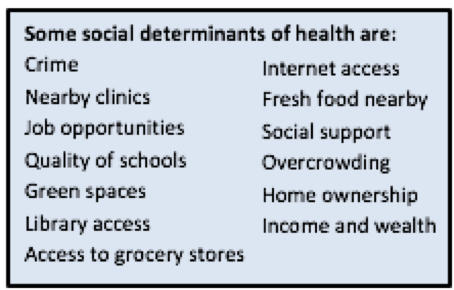Frontline Blog
Health Equity and Minority Health in Bexar County and the City of San Antonio
April 2017
By Vincent R. Nathan, PhD, MPH, San Antonio Metropolitan Health District

“Bridging Health Equity Across Communities” is the theme of this April’s U.S. Department of Health and Human Services (HHS) Office of Minority Health (OMH) National Minority Health Month. Over the past month, HHS OMH, with their partners, worked to raise awareness about efforts across health, education, justice, housing, transportation and employment sectors to address the factors known as the social determinants of health – environmental, social and economic conditions that impact health. San Antonio, Texas joins DHHS in celebrating, and more importantly, recognizing the disparities in health among different groups.

Place-based equity or inequity, (i.e., where we live, learn, work and play) have a tremendous impact on our health. Receiving proper medical care and regular health provider visits are essential for detecting and curing illness. Access to clinical health care only accounts for 10 to 15 percent of preventable deaths. Social factors such as housing, education, income, transportation, access to healthy affordable food, and employment greatly influence the health and quality of life in communities. These also influence whether individuals have or use parks and playgrounds to exercise, full-service supermarkets to buy fresh and affordable fruits and vegetables, living-wage paying job opportunities to support their families, and other, necessary resources that allow them to thrive.
San Antonio, and several subsectors of Bexar County, are disproportionately affected by chronic disease. An unsupportive food and physical activity environment and a lack of focus on prevention have contributed to high rates of chronic disease morbidity and mortality, largely from cancer, heart disease, and diabetes.
The San Antonio Metropolitan Health District (Metro Health) has developed an Office of Health Equity with the opportunity and potential to address the needs of racial and ethnic minority populations by reducing the cost of health care, increasing the investment in prevention and wellness, supporting primary care improvements and creating partnerships between public health and health care field and social services. This opportunity is grounded in social determinants of health, with the continuing goal of eliminating health disparities.
Health Equity/Health Disparities

In 1979, Healthy People: The Surgeon General’s Report on Health Promotion and Disease Prevention providednational goals for reducing premature deaths and preserving independence for older adults. In 1980,another report, Promoting Health/Preventing Disease: Objectives for the Nation, set forth 226 targeted healthobjectives for the Nation to achieve over the next 10 years.In September, 1990, the HHS proposed a challenge to the nation to significantly change the health profile of America through the paradigm of prevention. The aim was titled “Healthy People 2000.” This challenge was to increase the span of healthy life for all Americans and reduce the disparities in health experienced by different groups through the prevention of disease and disability. Ten years later, “Healthy People 2010” was designed to achieve two overarching goals:
- Increase quality and years of healthy life, and
- Eliminate health disparities.
Today, we are in the end stage of the “Healthy People 2020” goals to:
- Attain high-quality, longer lives free of preventable disease, disability, injury, and premature death.
- Achieve health equity, eliminate disparities, and improve the health of all groups.
- Create social and physical environments that promote good health for all.
- Promote quality of life, healthy development, and healthy behaviors across all life stages.
Healthy People 2020 defines health equity as the “attainment of the highest level of health for all people.” This requires particular attention to groups that have experienced major obstacles to health associated with socio-economic disadvantages and historical and contemporary injustices. This includes health of disadvantaged populations and the contributions of race, class, wealth, education, geography, and employment to health status. Thus, HP2020 is a continuation of the vision of HP 2010, with the added approach being the Social Determinants of Health, which is a place-based organizing framework.
Health inequities, on the other hand, are differences in health that are not only unnecessary and avoidable but are considered unfair and unjust. Health inequities are rooted in social injustices that make some population groups more vulnerable to poor health than other groups.